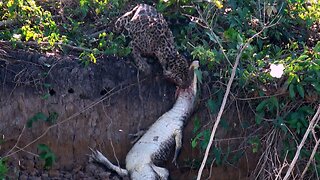Premium Only Content

Beautiful view of Tortoise
Tortoises are found worldwide with the most famous tortoise of all, the Giant Tortoise Lonesome George who lives on the Galapagos Islands near Ecuador. Tortoises, like their aquatic cousins, the Turtles, have a hard shell which protects their body
The top shell is called the carapace (a dorsal section of an exoskeleton or shell) and the bottom is called the plastron (the nearly flat part of the shell structure). The carapace and the plastron are connected by what is called the ‘bridge’. The shell is covered with scutes which are scales that are made of keratin (the same protein that our fingernails are made of). The carapace can help indicate the age of the tortoise by the number of concentric rings, much like the cross-section of a tree.
Many tortoises can retract their head, their four limbs and tail into the shell for protection. Tortoises have a beak but no teeth and no external ears, just two small holes on the sides of the head. Tortoises can vary in size from a few centimetres up to two metres in length. Male tortoises tend to have a longer, protruding neck plate than their female relatives.
Tortoises tend to be diurnal (active during the day) animals with tendencies to be crepuscular (animals that are primarily active during the twilight), depending on the ambient temperatures. Tortoises are generally reclusive and shy creatures.
TORTOISE DIET
Most land based tortoises are herbivores, feeding on grazing grasses, weeds, leafy greens, flowers and certain fruits. Their main diet consists of alfalfa, clover, dandelions and leafy weeds.
TORTOISE REPRODUCTION

Female tortoises dig and lay about a dozen eggs in burrows or holes they dig.
Hatchlings take approximately 90 – 120 days to incubate from eggs the size of a ping-pong ball.
The hatchlings break out of their shells with a front beak. Most hatchlings are born with an embryonic egg sac which serves as a source of food for the first couple of days. Tortoise hatchlings are capable of eating solid food in about 3 – 7 days.
TORTOISE LIFE SPAN
Tortoises generally have life spans comparable with those of human beings, however, some tortoises have been known to have lived longer than 150 years.
TORTOISE HISTORY
Tortoises and Turtles have existed since the era of the dinosaurs, some 300 million years ago. Tortoises and Turtles are the only surviving branch of the even more ancient clade Anapsida, which includes groups such as the procolophonoids, millerettids and pareiasaurs. Most of the anapsids became extinct in the late Permian period, with the exception of the procolophonoids and the precursors of the testudines (turtles and tortoises).
-
 LIVE
LIVE
The Bubba Army
20 hours agoNick Hogan Sues Bubba to BLOCK the DOC - Bubba the Love Sponge® Show | 9/03/25
5,261 watching -
 33:25
33:25
Uncommon Sense In Current Times
14 hours ago $0.02 earnedHollywood’s Woke Agenda Exposed | Kevin Sorbo on Cancel Culture, Faith & the Common Sense Revolution
4.16K -
 8:23
8:23
The Art of Improvement
19 hours ago $0.04 earned7 Smart Habits to Boost Mental Clarity
721 -
 12:09
12:09
China Uncensored
10 hours agoI Have NEVER Been More Furious
1.1K12 -
 2:12
2:12
WildCreatures
4 days ago $0.59 earnedThe beauty and mystery of the Pantanal, Brazil's best secret
1.73K2 -
 9:38
9:38
Millionaire Mentor
17 hours agoBernie Sanders LOSES IT After Scott Bessent’s Shocking Comeback
783 -
 1:35:35
1:35:35
Dialogue works
1 day ago $0.38 earnedLarry C. Johnson & Paul Craig Roberts: Trump’s Plan COLLAPSES as Russia Strikes — Xi & Modi Rise!
8493 -
 14:09
14:09
Zoufry
2 days agoThe Hunt for The Biggest Art Thief in US History
1383 -
 29:23
29:23
DeVory Darkins
1 day ago $12.92 earnedTrump makes BOMBSHELL Announcement as Democrat Judge issues SHOCKING Order
12.8K174 -
 28:31
28:31
James Klüg
1 day agoDemocrats Are FURIOUS With Trump’s Immigration Policy But Know Nothing About It | Part 2
14K20